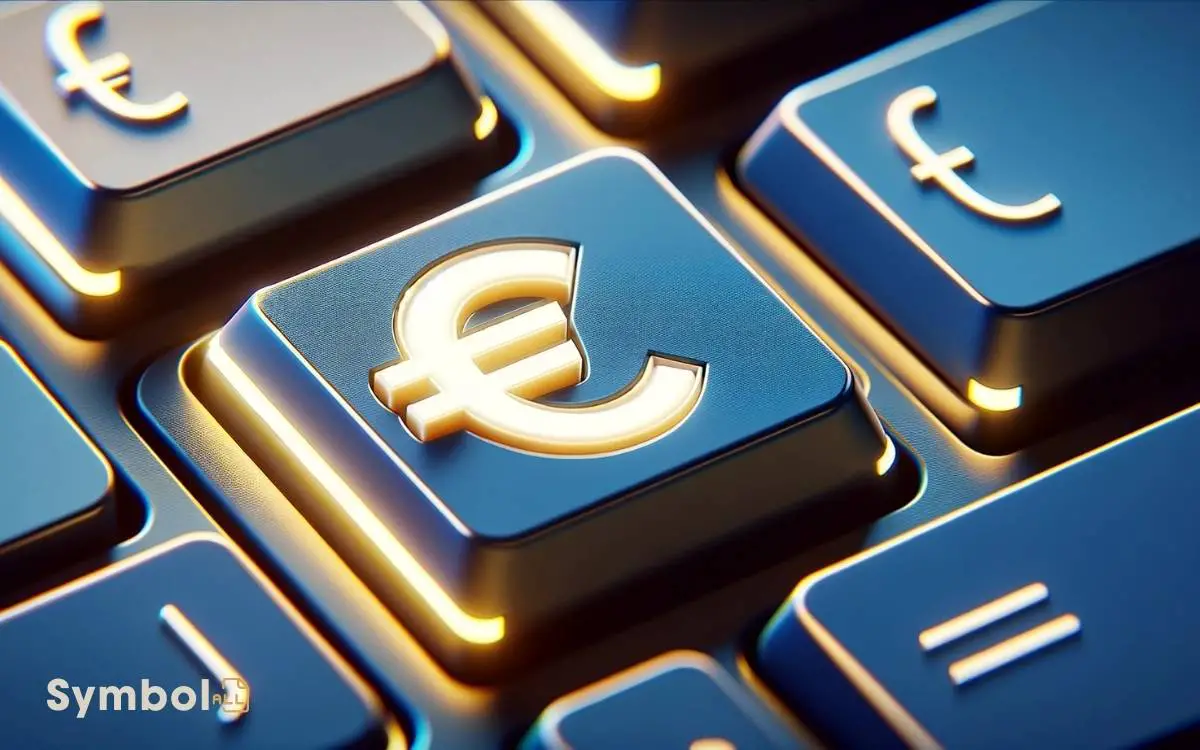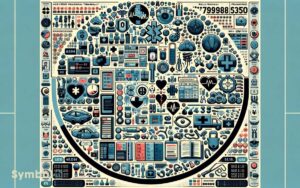How to Use Euro Symbol? Hold ‘Alt’ and Type ‘0128’!
To use the euro symbol (€) on a Windows device, hold ‘Alt’ and type ‘0128’ with Num Lock on. On a Mac, press ‘Option’ + ‘Shift’ + ‘2’. In Microsoft Word, the shortcut is ‘Ctrl’ + ‘Alt’ + ‘E’, and in Excel, use ‘Ctrl+Shift+€’.
For web development, insert the HTML entity ‘€’ into your code. Customizing your keyboard settings can also make accessing the euro symbol quicker, enhancing your typing efficiency.
By incorporating these shortcuts, you’ll guarantee your financial documents look professional and are easier to produce. Discovering more about the euro symbol can reveal new ways to streamline your workflow.

Key Takeaways
Understanding the Euro Symbol
The Euro symbol, represented as €, is the official currency sign used by countries within the Eurozone. You’ll find it’s essential for transactions within this area, acting as a uniform method for pricing goods and services.
Adopted in 1999, it symbolizes a significant step toward European economic unity. Understanding its design is straightforward; it combines the letter ‘E’ with two parallel lines to signify stability.
When you’re traveling or conducting business in Europe, recognizing and using this symbol becomes second nature. It’s more than just a currency sign; it’s a marker of the shared economic identity among its member states.
Familiarizing yourself with the € is your first step toward exploring the Eurozone’s economy efficiently.
Using the Euro Symbol in Windows
If you’re using a Windows computer, you can easily insert the Euro symbol by pressing the ‘Alt’ key along with ‘0128’ on your numeric keypad. This shortcut is straightforward, but remember, your Num Lock must be turned on.
Here’s a quick guide to make sure you’re doing it correctly:
| Action | Key Combination |
|---|---|
| Turn on Num Lock | `Num Lock` |
| Insert Euro Symbol | `Alt` + `0128` |
Using the Euro symbol in Windows doesn’t require any special software or settings adjustments beyond this simple step.
Just locate the numeric keypad on the right side of your keyboard, hold down the ‘Alt’ key, and type 0128. Release the ‘Alt’ key, and the Euro symbol (€) will appear in your text.
Euro Symbol Shortcuts for Mac
Switching to a Mac, you’ll find inserting the Euro symbol just as simple, albeit with a different key combination. To type the Euro (€) sign, simply press the ‘Option’ key along with the ‘Shift’ and ‘2’ keys simultaneously.
This quick keystroke guarantees you won’t miss a beat when needing to input the currency symbol in your documents or emails.
It’s important to remember that keyboard layouts can vary depending on your Mac’s regional settings, but the described combination works for most English language keyboards.
If you’re using a keyboard layout that doesn’t support this shortcut, checking your Mac’s system preferences for keyboard settings might offer alternative methods.
This shortcut is designed to make your typing experience efficient and hassle-free, keeping you productive in your tasks.
Inserting Euro in Microsoft Word
When you’re working in Microsoft Word and need the Euro symbol, you’ve got options. You can use a quick keyboard shortcut, find it in the Symbol menu, or even change your font to access it.
Each method serves a different need, ensuring you can insert the Euro sign seamlessly into your document.
Keyboard Shortcut Method
One quick method to insert the Euro symbol in Microsoft Word is by using a keyboard shortcut. This technique is straightforward and saves time, especially if you’re working on a document that requires frequent use of the Euro symbol.
To do this, simply press ‘Ctrl’ and ‘Alt’ keys on your keyboard, followed by the letter ‘E’. This combination instantly inserts the Euro symbol (€) into your document. It’s that simple.
Symbol Menu Insertion
If you prefer using menus over keyboard shortcuts, Microsoft Word allows you to insert the Euro symbol through its Symbol menu with just a few clicks. Begin by opening your document and place your cursor where you’d like the Euro symbol to appear.
Navigate to the ‘Insert’ tab at the top of the page. From here, click on the ‘Symbol’ option, usually found at the far right of the menu. A dropdown will appear; select ‘More Symbols.’ A dialog box opens, showcasing a variety of characters.
Look for the Euro symbol (€) or type ‘Euro’ in the search box to find it quicker. Once found, click on the Euro symbol, then hit the ‘Insert’ button. Close the dialog box, and you’ll see the Euro symbol in your document.
Font Change Technique
You can also adjust the font in Microsoft Word to insert the Euro symbol quickly. Here’s how:
First, highlight the text where you want the Euro symbol to appear. Then, navigate to the ‘Home’ tab on the ribbon at the top. Look for the ‘Font’ section.
Click on the font dropdown menu and select a font that supports the Euro symbol, such as Arial or Times New Roman. Once you’ve chosen the font, press ‘Alt’ + ‘E’ on your keyboard.
This shortcut might vary, so if it doesn’t work, try holding down the ‘Alt’ key while typing ‘0128’ on the numeric keypad. This technique ensures the Euro symbol appears precisely where you need it, seamlessly integrating into your document.
Adding Euro Symbol in Excel
Now, let’s focus on how you can add the Euro symbol in Excel, which is essential for managing financial data that involves this currency.
You’ll learn about using the keyboard shortcut method for quick insertion and the Excel Format Cells feature for more tailored formatting options.
These tools streamline the process, ensuring your financial reports accurately reflect the correct currency symbol.
Keyboard Shortcut Method
To quickly insert the euro symbol in Excel, press Ctrl+Shift+€ on your keyboard. This shortcut is a fast and efficient way to add the euro symbol without browsing through menus or guaranteeing through complex codes.
It’s particularly useful when you’re working with financial data that involves multiple currencies. After pressing these keys, the euro symbol (€) will immediately appear in your selected cell.
Remember, this method is straightforward; there’s no need for additional steps or configurations. It’s all about pressing the right combination of keys. This simplicity saves you time, especially when you’re dealing with large datasets.
Just assure your cursor is in the correct cell where you want the symbol to appear before using the shortcut. This method enhances your productivity by streamlining the process of adding currency symbols in your Excel sheets.
Excel Format Cells
Another method for adding the euro symbol in Excel involves using the Format Cells feature to customize your data’s appearance.
Here’s how you do it:
- Select the cells where you want the euro symbol.
- Right-click and choose ‘Format Cells’.
- In the ‘Number’ tab, select ‘Currency’.
- From the ‘Symbol’ dropdown, pick the euro symbol (€).
- Click ‘OK’ to apply.
This way, numbers in your selected cells will now show the euro symbol, aligning financial data neatly.
| Step | Action |
|---|---|
| 1 | Select cells |
| 2 | Right-click, choose ‘Format Cells’ |
| 3 | Go to ‘Number’ tab, select ‘Currency’ |
| 4 | Pick € from ‘Symbol’ dropdown |
| 5 | Click ‘OK’ |
Euro Sign on Mobile Devices
Accessing the euro sign on mobile devices involves a few simple steps you can quickly follow.
If you’re using a smartphone or tablet, begin by opening your keyboard as if you’re about to type a message or note.
For most devices, you’ll find the euro sign (€) by switching to the numeric or symbols keyboard. This usually requires tapping a button labeled ‘123’ or ‘?123’, depending on your device.
Once there, look for the euro symbol. It might be visible directly, or you might need to press and hold the dollar sign or another currency symbol to reveal it. Tap the euro sign to insert it into your text.
Utilizing Euro in Google Docs
When you’re working in Google Docs, incorporating the euro symbol (€) into your document is straightforward and efficient.
All you need to do is press `Alt` + `E` on your keyboard if you’re using a Windows computer. For Mac users, the shortcut is `Option` + `Shift` + `2`.
Alternatively, you can insert the euro symbol by clicking on ‘Insert’ at the top menu, selecting ‘Special characters,’ and then typing ‘Euro’ into the search bar. This method allows you to find and insert the euro symbol without memorizing keyboard shortcuts. Alternatively, you can insert the euro symbol by clicking on ‘Insert’ at the top menu, selecting ‘Special characters,’ and then typing ‘Euro’ into the search bar. This method allows you to find and insert the euro symbol without memorizing keyboard shortcuts. If you’d rather use a shortcut, you can look up keyboard alt key symbols for a more direct approach. These symbols provide an efficient way to insert various characters, including the euro symbol, by using numeric codes with the ‘Alt’ key. Whichever method you choose, it’s all about selecting the one that works best for your workflow.
It’s perfect for ensuring your financial documents, reports, or any text requiring the currency symbol are accurate and professionally formatted.
Incorporating Euro in Email
After mastering the use of the euro symbol in Google Docs, you’ll find incorporating it into emails is just as straightforward.
Here’s how to seamlessly include the euro symbol in your email communications, evoking a sense of professionalism and attention to detail:
- Copy-Paste: Simply copy the euro symbol (€) from any source and paste it directly into your email body.
- Keyboard Shortcut: Use the keyboard shortcut `Alt` + `0128` on Windows or `Option` + `Shift` + `2` on Mac to insert the euro symbol quickly.
- Character Map: Access the character map on your computer, find the euro symbol, and insert it into your email.
Euro Symbol in HTML
To incorporate the euro symbol in HTML, you’ll simply use the entity `€`. This approach guarantees that the euro symbol appears correctly on any webpage, irrespective of the underlying encoding.
It’s a simple method that involves inserting `€` wherever you want the euro symbol to appear in your HTML code. This method is universally acknowledged across different browsers and platforms, making it a dependable choice for web developers and content creators.
Customizing Keyboard for Euro
To incorporate the Euro symbol seamlessly into your typing, you’ll want to customize your keyboard.
This involves exploring keyboard layout options, setting up shortcut key commands, and adjusting your software settings.
Each step guarantees you’re equipped to use the Euro symbol efficiently in any document.
Keyboard Layout Options
You can personalize your keyboard layout to easily type the euro symbol. This simple adjustment can greatly enhance your typing efficiency, especially if you frequently deal with currencies.
Customizing your keyboard layout might seem challenging, but it’s a straightforward process that brings a sense of accomplishment and ease to your daily tasks.
Consider these three key points:
- Satisfaction: Feel the joy of mastering new tech skills.
- Efficiency: Save valuable seconds every time, adding up to hours saved in the long run.
- Precision: Mistakes in financial documents can be costly. Personalizing your keyboard for the euro symbol helps in reducing those pesky errors.
Shortcut Key Commands
After mastering your keyboard layout for efficiency, let’s explore how shortcut key commands can further streamline typing the euro symbol. Regardless of your operating system, there’s a quick way to insert this currency sign without browsing through menus.
On Windows, pressing ‘Alt’ plus ‘0128′ on your numeric keypad inputs the euro symbol directly into your document. If you’re using a Mac, the shortcut is slightly different; simply hold down ‘Option’ and press ‘2′.
These shortcuts might feel awkward at first, but with a bit of practice, they’ll become second nature, allowing you to type the euro symbol effortlessly. Remember, consistency is key to making these shortcuts a seamless part of your typing repertoire.
Software Settings Adjustment
Adjusting your software settings to customize the keyboard for the euro symbol can greatly enhance your typing efficiency.
This process allows you to seamlessly integrate the euro symbol into your daily typing activities, without the need for complex shortcuts or constant character map references.
Here’s how you can evoke emotion and make this adjustment:
- Feel Empowered: Navigate to your computer’s language and input settings. Adding the euro symbol as a part of your keyboard layout gives you the power of seamless communication across borders.
- Experience Relief: Select the euro symbol option. Knowing it’s just a keystroke away relieves the stress of searching for it every time.
- Embrace Convenience: Save your settings. Enjoy the convenience of having the euro symbol at your fingertips, ready to use whenever you need it.
Troubleshooting Common Issues
Despite your best efforts, you might encounter issues when trying to use the euro symbol. One common problem arises if your keyboard layout doesn’t support the euro symbol directly.
In this case, verify that your software is up-to-date, as older versions mightn’t recognize newer currency symbols. Another issue could be related to your operating system‘s language settings. If they’re not set to a European language, the euro symbol mightn’t display correctly.
Additionally, check that your font supports the euro symbol; some older or more obscure fonts lack this character. If you’ve tried these steps and still face problems, it’s worth consulting your device’s support documentation.
Remember, troubleshooting is a process of elimination. Start with the simplest solutions before moving to more complex ones.
Alternative Methods for Euro
If you’re struggling to use the euro symbol, there’s hope with several alternative methods available. Sometimes, the standard shortcuts just don’t work for you, and that’s okay.
Here’s a list of three alternative methods that might just solve your problem:
- Copy and Paste: Find the euro symbol (€) online or in a document you have, then simply copy and paste it where needed. It’s quick and foolproof.
- Character Map: Use the character map application on your computer. It allows you to view and select from all characters available, including the euro symbol.
- Online Tools: Several websites offer free tools to generate the euro symbol. Just search, click, and you’re set to include it in your documents.
Each of these alternatives offers a straightforward solution, ensuring you’re never left without a way to denote euros in your work.
Tips for Remembering Shortcuts
While exploring alternative methods for using the euro symbol is helpful, mastering keyboard shortcuts can greatly streamline your workflow. To remember these shortcuts, associate them with something familiar.
For instance, the euro symbol shortcut often includes the ‘E’ key, which naturally stands for ‘Euro.’ Think of it as pressing the ‘E’ for ‘Economy’ in Europe.
Another tip is to practice regularly. Muscle memory is a powerful tool. The more you use these shortcuts, the less you’ll have to think about them. Start by integrating them into your daily tasks.
Lastly, keep a cheat sheet handy until you’re comfortable. Place it somewhere visible by your workstation. It’s a great reminder and will help reinforce your memory. With these strategies, you’ll find using the euro symbol becomes second nature.
Conclusion
Now that you’ve danced through the steps of releasing the euro symbol across different platforms, imagine it as your passport to a world where numbers meet culture.
Whether you’re crafting documents in Word, finessing spreadsheets in Excel, or simply expressing values in messages, the euro symbol is your ally.
Remember, with the shortcuts etched in your mind and troubleshooting tips up your sleeve, every currency symbol, especially the euro, becomes a breeze to summon.
Keep exploring, keep typing, and let the euro symbol be your guide in this digital domain.






